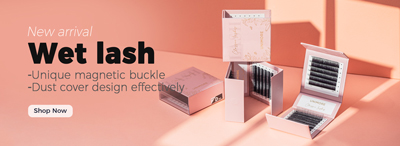It is possible that as a skilled lash artist, clients will come to you and look for advice regarding lash extensions. Especially if they think they had a reaction after receiving extensions. It’s important to never give clients medical advice, but it’s important to keep informed on the symptoms and causes of irritation.
If you are a lash artist, it is essential to distinguish between an allergic reaction and an irritant in order to provide your client with the finest care possible.
In this article, we’ll go into greater detail on the potential causes of reactions, allergies, and irritation as well as some strategies for minimizing them.
- 1 Difference between Lash Allergy and Lash Irritation
- 2 The symptoms of Lash Extension Allergy & the Cause of it
- 3 The reason why clients have lash extension allergy
- 4 Prevent Lash Extension Allergy
- 5 What to do if a client has a lash allergy?
- 6 Cause of Eyelash Extension Irritation
- 7 Symptoms of Lash irritation
- 8 How to reduce the irritation
- 9 5 Professional tips to reduce lash irritation when applying for extensions
- 10 Final Thoughts
Difference between Lash Allergy and Lash Irritation
First of all, lash extension allergies and irritation are completely different. Having allergies are intense and lasts a long time, whereas irritations are just some minor discomfort that typically goes away fast.
To begin, an allergy is a very sensitive immune system response to substances known as allergens. To put it simply, lash extension allergies occur when something triggers an allergic response.
Lash irritation, on the other hand, is a reaction to a previously experienced event. So irritation is a response to a chemical irritant.
If a client has an allergy, then the options for using glue adhesive are limited.
Just as not everyone is sensitive to everything, there are multiple lash extension allergies with a wide variety of symptoms and reactions that manifest differently in individual people.
You might be wondering how we can tell the difference now. Here is a list where it can help you understand better.
Lash Allergy:
- It can show after clients receive lash extensions or it might also appear after 24 to 48 hours.
- It might affect one or both of their eyes.
- One eye will experience a significant reaction.
- It can last anywhere from a few hours to a few days.
- If it doesn’t get treated, the conditions will become worse over time.
- Clients can have lash extension allergies after years of wearing extensions which can make things a little unexpected.
Lash Irritation:
- Those with sensitive skin are more likely to experience irritation.
- It happens quickly, like within minutes. Mostly when clients get an extension done and it will go away by itself in a few hours as the glue dries down.
- In most cases where the glue comes into touch with the skin or eyes, it will increase the risk of getting irritations. It relies on how quickly the glue dries, the weather, and how skilled is the lash artist.
- Typically affects just one eye
- Different eyes may react differently.
- Most of the time it will be gone after a day.
- The irritations will be increased each hour that passes.

The symptoms of Lash Extension Allergy & the Cause of it
Contrary to lash extension allergies, lash irritations are brought on by poor sanitation, ineffective application, seasonal allergies, or even just the fact that the lash glue made contact with their skin rather than hair strands. To avoid allergic reactions from clients, it is crucial to keep your lash room and equipment clean and sanitized.
Make sure to warn your clients not to open their eyes while having their lashes done before applying lash extensions to them. It will cause the risk of irritation. Allergies, however, are messier and more complicated.
What are the signs of lash allergy now? Lash allergies can show multiple symptoms at once. The most typical symptoms are listed below, though they may vary according to the people’s bodies. But at Gollee our experts will assist you in identifying lash allergy.
The symptoms are:
- Itching
- Burning
- Redness
- Stinging
- Watery eyes
- Irritation
- Swelling
- Runny nose
*FACT: Only 3% of people who get eyelash extensions experience allergies to the lash glue.
While lash allergies are uncommon, lash adhesives are typically to blame. Clients may experience allergies as a result of the ingredients used in lash glue. Carbon black is a common allergen found in lash glue. It is a dye that gives the lash glue its dark color. Nevertheless, it rarely affects people and it depends on your biology.
Because of this, individuals who are sensitive to eyelash extension adhesive or any of its components frequently experience symptoms including redness, swelling, puffiness, and itching around their eyes.
In addition to lash glue, the tape may also be to blame for allergic responses during eyelash extensions. Most of the time you use tapes to keep your client's eyes closed when getting lash extensions done.
Also, ingredients in many products that the clients use on, near, or in their eyes could cause an allergic reaction in some people. These can consist of: eye makeup, facial cleanser, or solutions for contact lenses.
Also, using and touching items with their hands can cause irritated eyelids if they touch their eyes constantly.
Allergies can be challenging. Sometimes you'll know right away whether clients are allergic to a new product. Sometimes a well-known cosmetic will unexpectedly start to make their eyelashes and eyelid itch.
The reason why clients have lash extension allergy
There are multiple reasons why clients have lash extension allergies. One reason might be that you are a new lash artist. Maybe you chose less expensive products or you are an unlicensed lash artist. Using outdated items like expired or old lash adhesive can lead to severe allergic reactions.
When you use new lash products on your clients or apply a new style can sometimes cause unexpected allergies.
* As a general rule, if clients are allergic to cats, dogs, or other animal furs, do not use mink fur fibers.
Another reason is blepharitis. Blepharitis may be to blame if clients have started a new aftercare routine or product. This typically occurs when their aftercare routine fails miserably. Blepharitis generally affects both eyes at the same time and affects the part of the eyelid where eyelashes grow.
Another issue to be aware of is the use of latex in lash adhesives which is used to strengthen the bond with the natural lash. Yet, few people have a latex allergy. Even if clients are not sensitive at first, latex can build up over time and create an allergic reaction. It is better to use a lash glue that doesn’t have latex in it.
In this situation, allergies may worsen over time.
It's important, as a lash artist, to identify exactly which of these components your clients are allergic to because there isn't a single lash extension adhesive composition that will work for everyone. Knowing will make all the difference; there is probably a lash extension adhesive out there that will work for them.
On our website, you can view the ingredients for our lash glue. Our team is here to help you with any questions you may have.
Prevent Lash Extension Allergy
One way to prevent clients from having lash allergies is to apply an anti-allergy gel. Applying an anti-allergy gel that doesn't conflict with their lash extension routine is the first step in preventing lash allergies.
If clients are allergic to the black dye, you can alternatively use a lash adhesive without carbon black.
One of the most crucial things you must do as a lash artist is test your clients for allergies before applying for extensions. Applying a drop of glue behind their ear or just a few extensions to the outside corner of their eye can be used to test for allergies. Negative responses frequently happen right away, but occasionally they can take a few hours. Make an appointment with your clients before the actual session to find out.
Also, if you have a lash business, give clients the option of scheduling a consultation appointment. Inquire if they have any allergies, if they are allergic to eyelash extensions, or if they have very sensitive eyes. This will allow you to apply for extensions without causing allergic reactions in your clients.
At Gollee we have different types of eyelash glue. You can see the product's ingredients on our website in case you are being overly cautious.
By discussing your concerns with our experts, they will offer you options for lash adhesives that contain fewer cyanoacrylates.
What to do if a client has a lash allergy?
The most important thing is to inform your clients not to rub their eyes. The eyelashes and the eyelash line may itch for a variety of reasons. It's crucial to avoid scratching irritated eyelashes because doing so could aggravate or even infect the area.
When a client comes in with an eyelash extension allergy, it is best to remove the lash glue from their eyes as soon as possible so that the allergy does not worsen.
If their allergy worsens and becomes infected, they should see a doctor.
Cause of Eyelash Extension Irritation
Usually, irritation results from incorrect gel pad placement, inadequate ventilation, or partially open eyelids during the treatment. As a lash artist, you must place the gel pad precisely and have adequate ventilation. The white part of the eye may get reddened and irritated for a few days if a gel pad is positioned too high up since it may move around during the session.
But many irritation-related symptoms can be mistaken for allergic response signs.
So here is how we'll tell them apart: An irritation gets better with time, whereas allergies get worse.
Incorrect pad placement, client opening eyes during the procedure, or improper ventilation in the lash room are the most common causes of irritations.
Irritation can result in itching, redness, and puffy eyes. It may indicate an allergic reaction if the redness or itching does not decrease or at least significantly improve within 24 hours.
It's crucial to remember that seasonal allergies might worsen the symptoms. So, if the client has seasonal allergies, you should inform them so that you can take extra precautions and select the best supplies for them.
The causes of lash extension Irritation:
- As previously stated, the biggest source of irritation when wearing lash extensions can be the lash glue. If clients experience irritation during their lash visit, it is due to the lash glue. It is best to remove the glue immediately.
- Misplacing eye pads are another source of irritation. From the perspective of a Lash Artist, this movement can occasionally be so slight as to go unnoticed. As a certified lash artist, you should be able to detect if the pads are misplaced. The positioning of the under-eye gel pads is really important because if it is placed wrong it could cause a mild irritant.

Symptoms of Lash irritation
As previously said, while irritations sometimes resemble allergies, they are usually less severe and disappear once the adhesive has healed. This typically occurs within the first 24 hours of the application. It's usually only a few hours later. It causes redness, itching, and watery eyes.
How to reduce the irritation
Here are some helpful hints for helping clients minimize their allergies and irritations before and after lash extension application:
- Have a well-ventilated lash room with a fan to keep vapors away from the eyes.
- Use a primer or pre-cleanse the lashes with a cleanser.
- Use tape or eye pads to avoid chemical burns.
- It's important that your clients understand how to take care of their eyelash extensions after getting them done. The lash artist must provide an explanation. Clients who pick or rub their eyes are likely to experience redness or irritation. To prevent irritation, you might provide Gollee aftercare products to your clients.
- If a client experiences irritation during the procedure, remove the lash glue and apply a cold compress to the affected area. This is more of a Band-Aid that eases discomfort rather than a treatment.
5 Professional tips to reduce lash irritation when applying for extensions
As we've previously discussed on our blog, applying for eyelash extensions typically takes hours, so it's crucial to take all reasonable measures to make the process enjoyable for your client and to eliminate any potential sources of discomfort. As we said, the most frequent irritant during lash applications is eye irritation. You can reduce this irritation for your clients by using the following advice:
- Make sure your clients keep their eyes closed
You should always be very clear with your clients about the necessity of keeping their eyes completely closed during the application process. The fumes might enter their eyes even if they only barely poke through. It will make their eyes watery and sting.
- Provide Ventilation
Given how long it takes to apply lashes, a stuffy room is the last place you want your client to be. Wherever it is possible, create ventilation to reduce the intensity of the fumes. Get a fan going and open any windows you can; the better the air circulation, the quicker the fumes will disintegrate.
- Apply less glue
Applying too many adhesives increases the likelihood that your client will become more irritated by the fumes. When you think about it, it's actually quite simple: the more glue you use, the more fumes you release, so use less adhesive overall for better outcomes.
- Use an adhesive that is made for sensitive eyes
If you've followed all of the above recommendations and a client still complains of eye irritation, you can consider using a sensitive-style adhesive. While they do not dry as quickly or as long as fast-dry adhesives, they are manufactured with a formula developed to appeal to consumers who are especially sensitive to the fumes from other types of eyelash glues.
- A Nano Mister can be used to decrease the fumes
In order to reduce the possibility of any eye irritation for your clients, the adhesive must cure as quickly as possible. Using a Nano mister can complete the process in only a few minutes. Your clients can open their eyes without being shocked by jarring smells thanks to the soothing mist. Click to learn about the Gollee Diamond Nano Mister.
Final Thoughts
It is essential to keep learning and being informed. Understand the symptoms of allergic reactions to eyelash extensions. However, it is imperative that you never offer medical advice to your consumers. If they are experiencing a severe response or if they have any health issues that could make them more likely to react, it is advised that they speak with a healthcare provider. All responses must be diagnosed by a doctor since if your client has an allergy to lash extension adhesive, they will be unable to have lash extensions again.
As an alternative, you could always provide a lash lift!
Every time you apply for eyelash extensions, we hope our guide will help you make the process easy, soothing, and stress-free. The more enjoyable a client's experience is with you, the more likely it is that they will return to you whenever they require professional eyelash services.
We hope you found this blog useful; as always, if you have any questions, please contact us via email. We will help you with any issues that you are facing.







